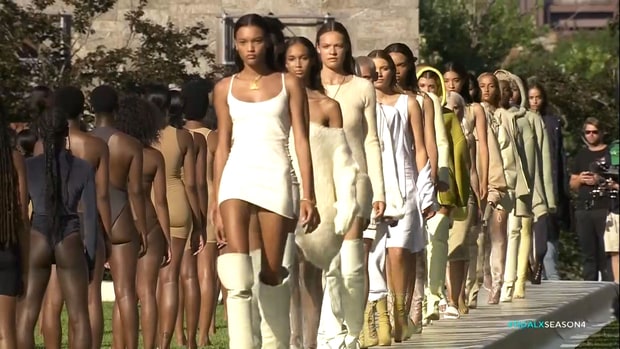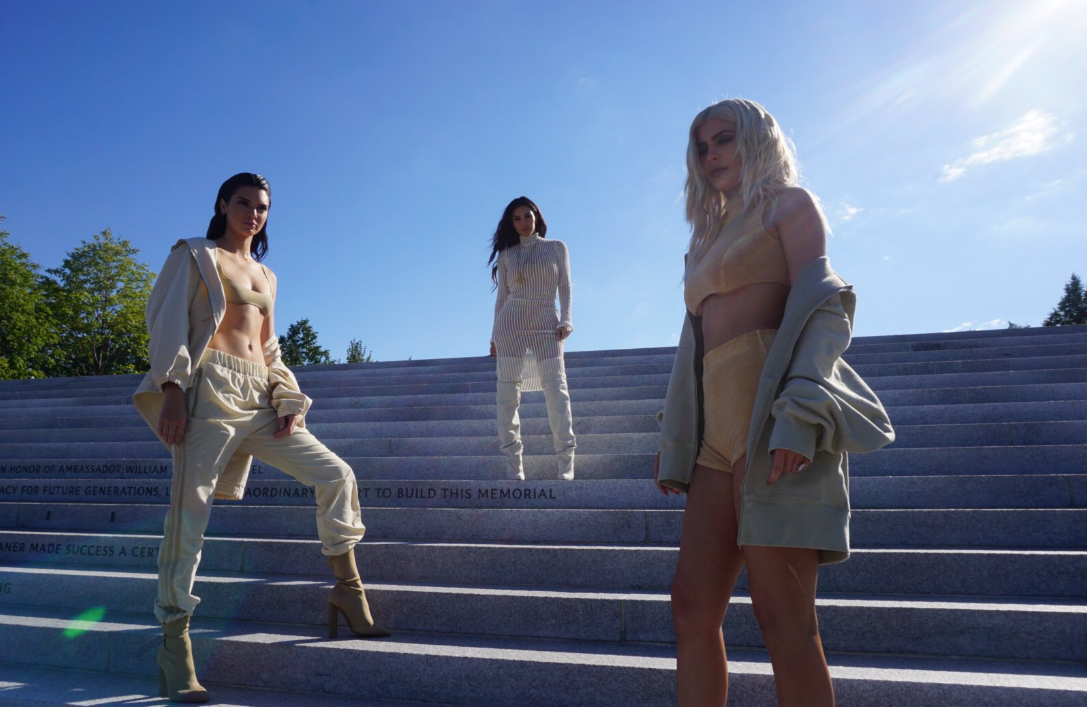
In 2011, Kanye showed his first collection under his own name at Paris Fashion Week to lukewarm reviews. Stylistically, it was an unsuccessful marriage between Christophe Decarnin-era Balmain and the momentous return of Phoebe Philo to Céline. Conceptually, it showed Kanye eager to prove himself as a serious designer: In the buildup to it, he ingratiated himself with creative directors and fashion editors and went so far as to intern at Fendi, the historic Italian luxury house known for its cutting-edge furs.
So it’s interesting that the clothes are now “apparel,” that Kanye’s line is, “I’m not saying that this is a fashion proposition, I’m saying that this is a human proposition.” To that end, the clothes purport to be genderless, seasonless, and post-trend. But if Yeezy is a departure from capital-F fashion, its showing on the first day of New York Fashion Week did nothing to dispel the sense that Yeezy is far from universal. The implication that Kanye’s cult label is for everyone is laughable when it’s clearly not for poor people, fat people, or people who aren’t hypebeasts, ever eager to cop the latest Supreme drop. No, Yeezy continues to be as exclusionary as it purports not to be while dealing in the visual currency of the dispossessed, those who have historically been subject to oppression and violence. The concept is given more consideration than the consumer.
Last season, we saw a harrowing past brought to life through the imagery of the Rwandan genocide; this season seems to have brought us to purgatory. After five combined collections between two brands, Yeezy continues to fall short of its supposed universality. Its image remains static and almost apathetic to the needs of its constituency. Once again, we’re subjected to show production from Vanessa Beecroft, an artist whose primary practice seems to be telling women—specifically black women—to stand still. In a curatorial sense, it’s not only troubling because it’s from a white woman, it also points to a fetish for placidity, of rendering subjects motionless so they can be consumed as a spectacle.
Kanye often talks about democratizing luxury, making beautiful things accessible to the general public. His best-selling offering, the Yeezy 350, is an entry-level product that only reinforces how inaccessible the rest of the collection is, especially compared to its predecessor, the Nike Roshe Run. Entry-level products like small leather goods, footwear, and fragrances are priced to allow more people to buy into the dream created by higher-priced offerings, often constituting a larger portion of sales as a result. Basically, these presentations sell shoes and bags; it’s why Chanel and Louis Vuitton send out a bag with every look.

Is the world made more beautiful by the proliferation of Yeezy merchandise, even if it’s mostly through Zara ripping off the color schemes? It’s difficult to say, but the more important question is: Does this collection of “elevated army surplus” pieces make the people wearing it more beautiful? The restrained palette we’ve seen in previous seasons has been updated in canary, lilac, and ecru, seen in protective shearlings and work jackets with oversized pockets. But underneath these colors lie others associated with war, conquest, and deprivation, the dusty browns and military greens that we’re led to believe are shades of impending dystopia. Overconstructed, oversized anoraks, and hoodies have a protective quality—the commonplace rendered high-concept with raw edges, shearling that almost functions like armor, and body-conscious construction. Discussing Season 2, Kanye highlighted sweatshirts as a critical piece of clothing, almost like blue jeans in their ubiquity and utility; their familiarity is the democratizing element that makes what some might call the “avant-garde” approachable.
Shoes arrived in several constructions: an updated version of the 350, a furry slide (no doubt inspired by the runaway success of Rihanna’s Puma collaboration), and two thigh-high boots, one in black suede with a stacked heel and the other a perilous stiletto in neutral suedes or clear acetate. As the show progressed, models were forced to remove their poorly constructed footwear, while others struggled to maintain their composure in the high heat and direct sunlight. Some even passed out as the Yeezy team stood by and did nothing. As a designer, Kanye is inconsiderate.As an employer, he is borderline abusive.
The significance of clothing is the impact it can make in people’s lives, whether through utility, lived experience, or pure aesthetic pleasure. If it doesn’t fulfill a purpose to someone, it’s functionally useless. I believe this is the first instance of street casting where instead of making the point that the clothes are for “real” people, they reinforced the opposite: that people’s needs were not taken into consideration, that their desires fell on deaf ears. They will be told what to desire.

Obviously people continue to buy it, so what does it mean to them? I wouldn’t know, because I don’t own it. But Yeezy means Kanye, and a connection to him is the ethos, the raison d’être. For the kid who scrambled together enough to brave the early morning lines, that kind of connection to a living, breathing legend could mean the world. But for those for whom Kanye isn’t the world, we get the sensation of being scammed. Don’t you feel a bit deceived, looking at these thigh-high boots made out of a material that sags under its own weight, as if exhausted of its own pretension? Or the bodysuits made out of a material that refuses to match the wearer’s complexion, that pays more attention to a woman’s image than the woman underneath it? If this is the apocalypse, women have been living it.
But at the end of the day, Kanye’s products are simply more disappointing than they are problematic, not only inherently meaningless like any other luxury product, but meaningless when the huge number of ideas piled onto them amounts to nothing. However, it’s also the case that we hold him up to higher, possibly unreasonable standards when many designers have done the same antics to critical acclaim. It’s just impossible to ignore the glaring contradictions between his “human” propositions and the clothes we’re shown. Kanye West doesn’t make clothing for humans—at least not real humans with real budgets, real jobs, and real lives to lead—they’re clothes for those with the privilege to live the fantasy of a glorious death.
[Source:-Noiesy]







